CHEVROLET CORVETTE 1994 4.G Owners Manual
Manufacturer: CHEVROLET, Model Year: 1994, Model line: CORVETTE, Model: CHEVROLET CORVETTE 1994 4.GPages: 274, PDF Size: 15.61 MB
Page 231 of 274
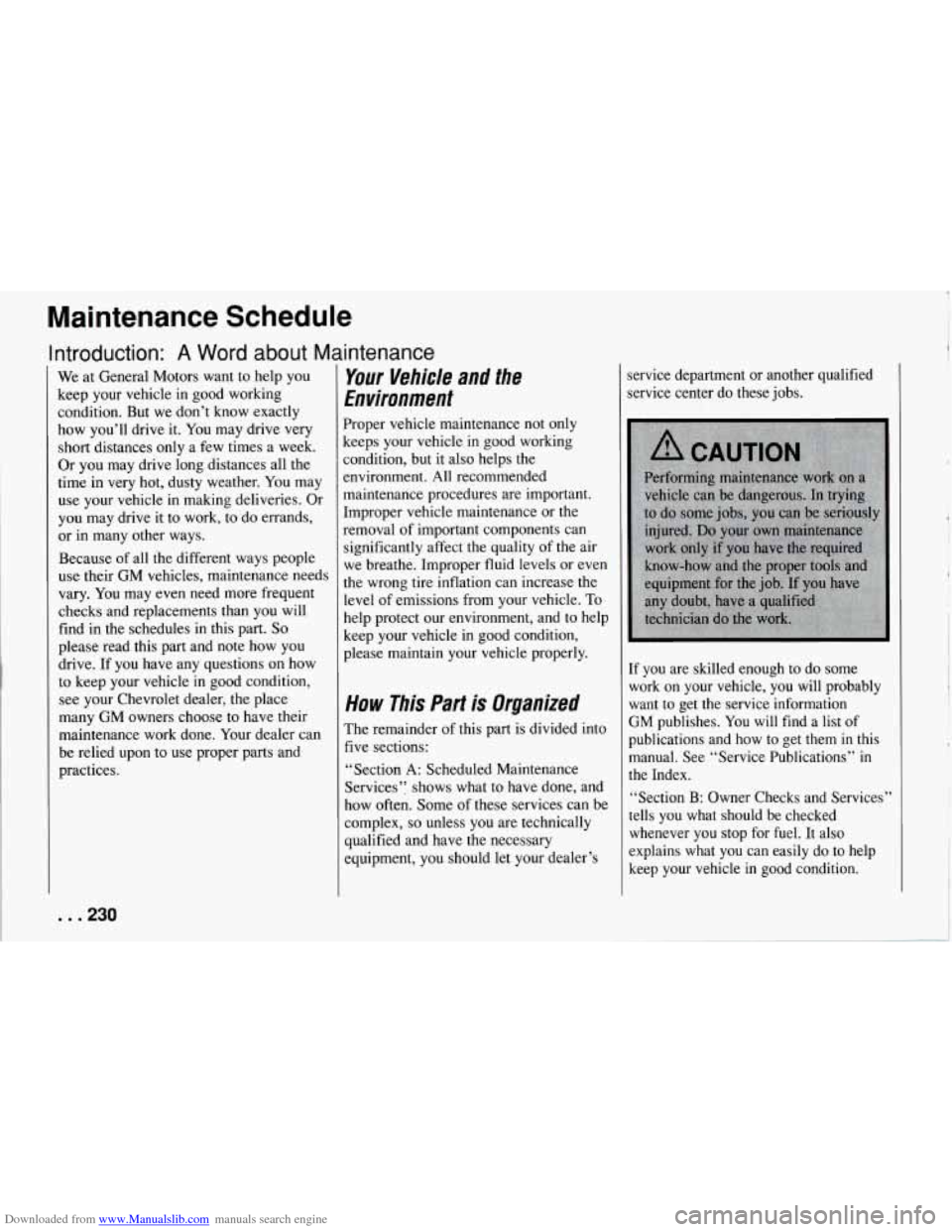
Downloaded from www.Manualslib.com manuals search engine Maintenance Schedule
Introduction: A Word about Maintenance
We at General Motors want to help you
keep your vehicle in good working
condition. But we don’t know exactly
how you’ll drive it. You may drive very
short distances only a few times a week.
Or you may drive long distances all the
time in very hot, dusty weather.
You may
use your vehicle in making deliveries. Or
you may drive it to work, to do errands,
or
in many other ways.
Because of all the different ways people
use their GM vehicles, maintenance needs
vary. You may even need more frequent
checks and replacements than you will
find in the schedules in this part.
So
please read this part and note how you
drive. If you have any questions on how
to keep your vehicle in good condition,
see your Chevrolet dealer, the place
many GM owners choose to have their
maintenance work done. Your dealer can
be relied upon to use proper parts and
practices.
Your Vehicle and I
Environment the
Proper vehicle maintenance not only
keeps your vehicle in good working
condition,
but it also helps the
environment. All recommended
maintenance procedures are important.
Improper vehicle maintenance or the
removal of important components can
significantly affect the quality of the air
we breathe. Improper fluid levels or even
the wrong tire inflation can increase the
level of emissions from your vehicle. To
help protect our environment, and to help
keep your vehicle in good condition,
please maintain your vehicle properly.
How This Part is Organized
The remainder of this part is divided into
five sections:
“Section
A: Scheduled Maintenance
Services’: shows what to have done, and
how often. Some of these services can be
complex,
so unless you are technically
qualified and have the necessary
equipment, you should let your dealer’s lified
service department or another
qua
service center do these jobs.
If you are skilled enough to do some
work on your vehicle, you will probably
want to get the service information
GM publishes. You will find a list of
publications and how to get them in this
manual. See “Service Publications”
in
the Index.
“Section B: Owner Checks and Services’’
tells you what should be checked whenever you stop for fuel. It also
explains what you can easily do to help
keep your vehicle in good condition.
1
. . .230
Page 232 of 274
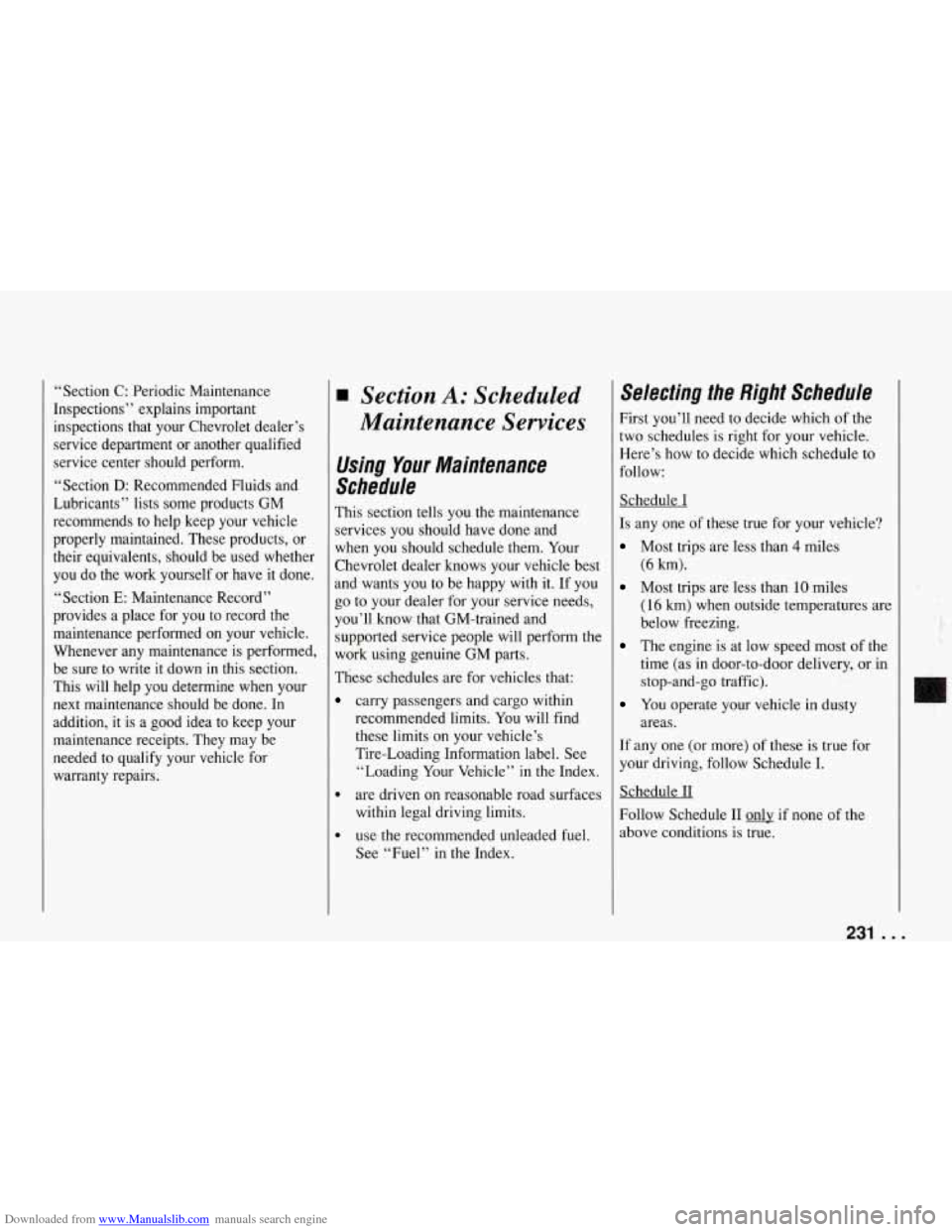
Downloaded from www.Manualslib.com manuals search engine “Section C: Periodic Maintenance
Inspections” explains important inspections that your Chevrolet dealer’s
service department or another qualified
service center should perform.
“Section
D: Recommended Fluids and
Lubricants” lists some products GM
recommends to help keep your vehicle
properly maintained. These products, or
their equivalents, should be used whether
you do the work yourself or have it done.
“Section
E: Maintenance Record”
provides a place for you to record the
maintenance performed on your vehicle.
Whenever any maintenance
is performed,
be sure to write it down in this section.
This will help you determine when your next maintenance should be done. In
addition,
it is a good idea to keep your
maintenance receipts. They may be
needed to qualify your vehicle for
warranty repairs.
Section A: Scheduled
Maintenance Services
Using Your Maintenance
Schedule
This section tells you the maintenance
services you should have done and
when you should schedule them. Your
Chevrolet dealer knows your vehicle best
and wants you to be happy with
it. If you
go to your dealer for your service needs,
you’ll know that GM-trained and
supported service people will perform the
work using genuine GM parts.
These schedules are for vehicles that:
carry passengers and cargo within
recommended limits. You will find
these limits on your vehicle’s
Tire-Loading Information label. See
“Loading Your Vehicle” in the Index.
are driven on reasonable road surfaces
within legal driving limits.
use the recommended unleaded fuel.
See “Fuel” in the Index.
Selecting the Right Schedule
First you’ll need to decide which of the
two schedules is right for your vehicle.
Here’s how to decide which schedule to
follow:
Schedule I
Is any one of these true for your vehicle?
Most trips are less than 4 miles
Most trips are less than 10 miles
(6 km).
(1 6 km) when outside temperatures are
below freezing.
The engine is at low speed most of the
time (as
in door-to-door delivery, or in
stop-and-go traffic).
You operate your vehicle in dusty
If any one (or more) of these is true for
your driving, follow Schedule I.
Schedule I1
Follow Schedule I1
o& if none of the
above conditions is true,
areas.
231 . . .
Page 233 of 274

Downloaded from www.Manualslib.com manuals search engine Maintenance Schedule
Section A: Scheduled Maintenance Services (Cont.)
Schedule I
Follow Schedule I if your vehicle is
MAINLY driven under one or more of
the following conditions:
0 When most trips are less than 4 miles
(6 km).
When most trips are less than 10 miles
(16 km) and outside temperatures
remain below freezing.
0 When most trips include extended idling and/or frequent low-speed
operation, as in stop-and-go traffic.
0 When operating in dusty areas.
Schedule
I should also be followed if the
vehicle
is used for delivery service. police,
taxi or other commercial applications.
* An Emission Control Service.
t The U.S. Environmental Protection Agency
or the California Air Resources Board has
determined that the failure to perform this
maintenance item will not nullify the emission warranty or limit recall liability prior to the
completion
of vehicle usefil life. General
Motors, however, urges that all recommended
maintenance services be performed at the
indicated intervals and the maintenance be
recorded in “Section E: Maintenance Record.”
WHAT TO SERVICE
See “Explanation of Scheduled
Schedules
I and II.
ITEM NO. Maintenance Services” following
WHEN TO PERFORM
Miles (kilometers) or Months
(whichever occurs first).
I I
1 I Engine Oil and Filter Change* 1 Every 3,000 miles (5 000 km) or 3 months.
2 I Chassis Lubrication I Every other oil change.
3
Cooling System Service” 4
Engine Adkessory Drive Belt Inspection
Every 30,000 miles (50 000 km) or 24 months.
5 I Transmission Service I
See “Explanation of Scheduled Maintenance
Services” following Schedules
I and 11.
6
7
Every 100,000 miles (166 000 km).
Spark Plug Replacement*
Every
30,000 miles (50 000 km).
Spark flug Wire Inspection*?
8 I Air Cleaner Filter Replacement* I
See “Explanation of Scheduled Maintenance
Services” following Schedules
I and 11.
9 I Fuel Tank, Cap and Lines Inspection*t Every 30,000 miles (50 000 km).
. . .232
Page 234 of 274
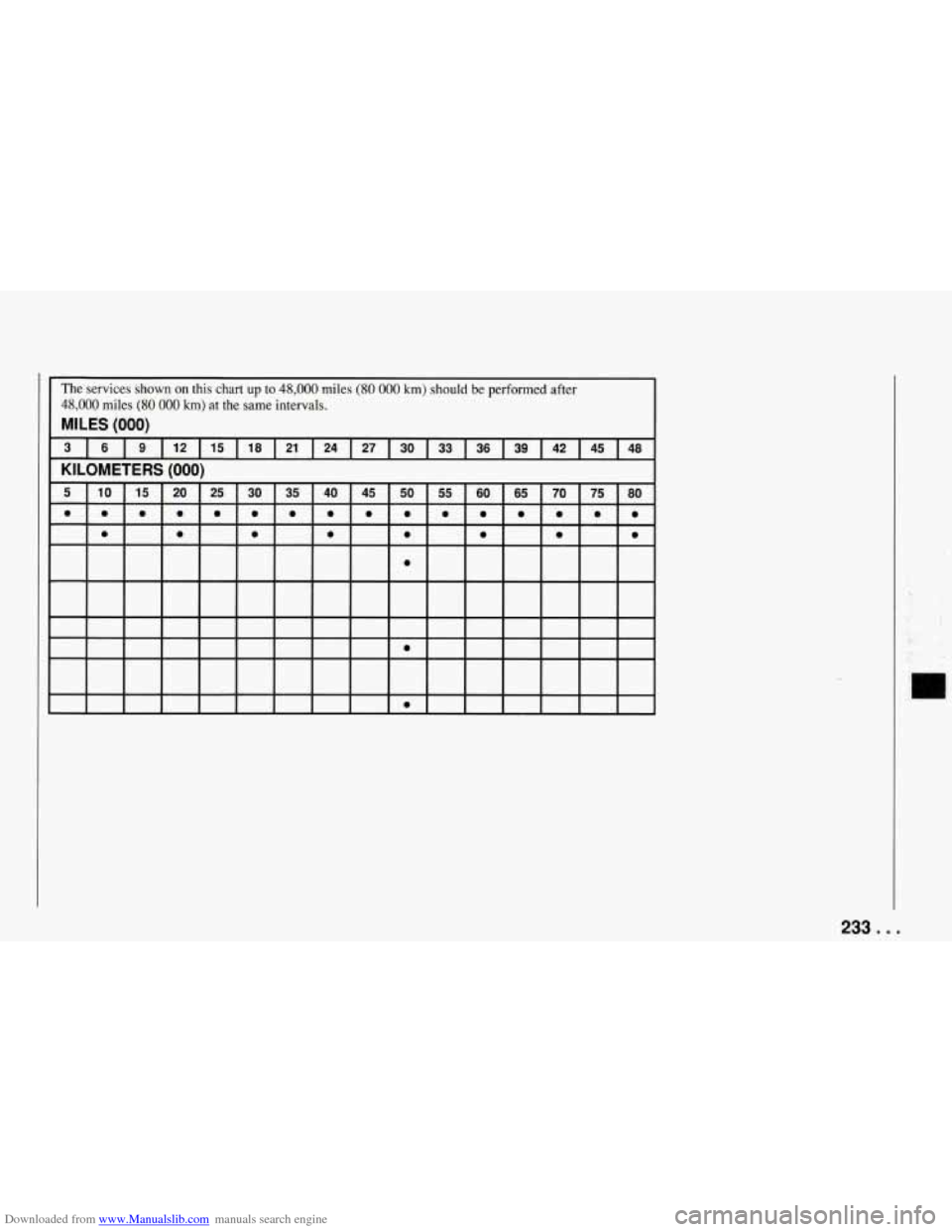
Downloaded from www.Manualslib.com manuals search engine The services shown on this chart up to 48,000 miles (80 000 km) should be performed after
48,000 miles
(80 000 km) at the same intervals.
MILES (000)
'r I
233. . .
Page 235 of 274
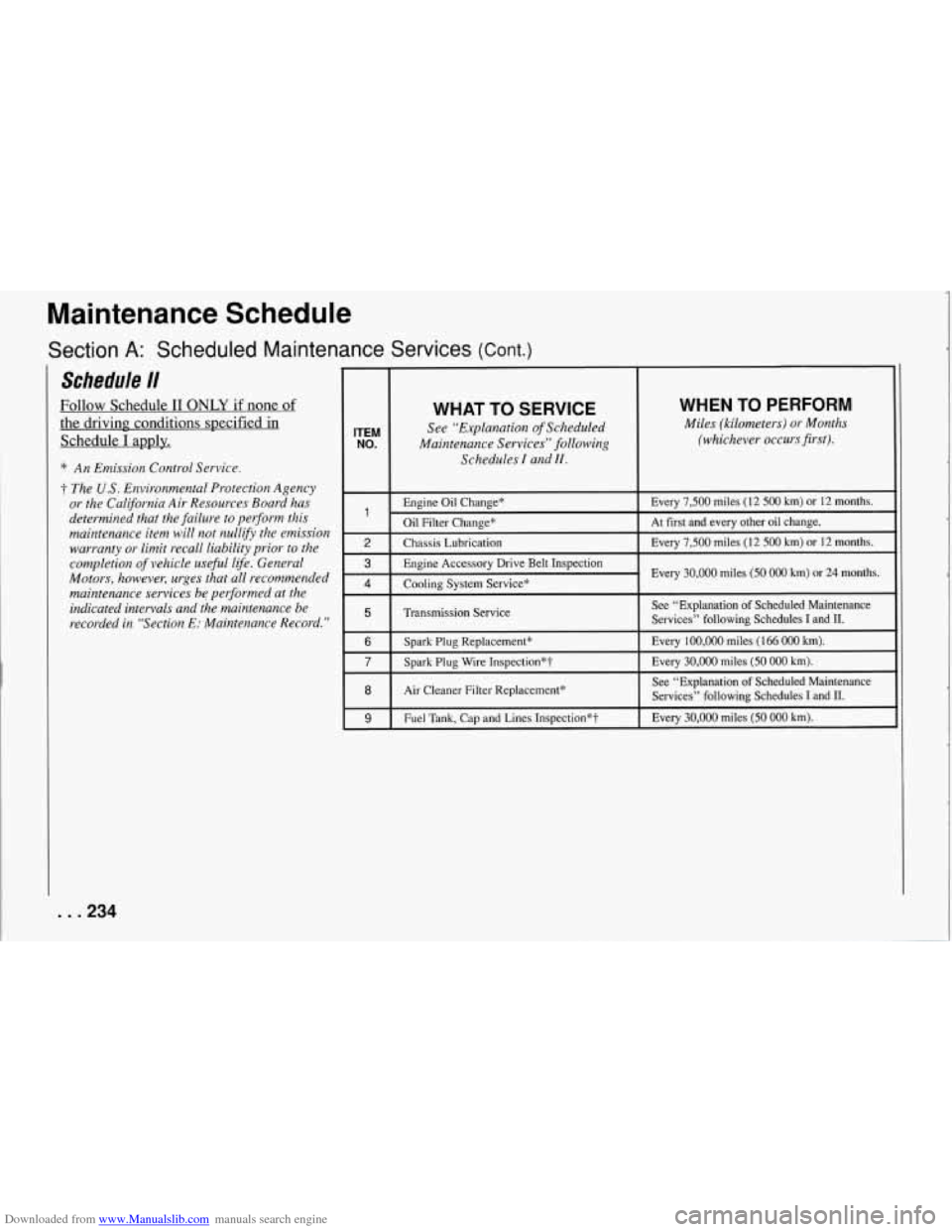
Downloaded from www.Manualslib.com manuals search engine Maintenance Schedule
Section A: Scheduled Maintenance Services (Cont.)
Schedule /I
Follow Schedule I1 ONLY if none of
the driving conditions specified in
Schedule
I apply.
* An Emission Control Service.
t The US. Environmental Protection Agency
or the California Air Resources Board has
determined that the failure to perform this
maintenance item will not nullify the emission
warranty or limit recall liability prior to the
completion
of vehicle useful life. General
Motors, however, urges that all recommended
maintenance services be performed at the
indicated intervals and the maintenance be
recorded in “Section E: Maintenance Record.”
. . ,234
ITEM NO.
2
3
4
5
6
-
-
7
8
-
9 -
WHAT TO SERVICE
See “Explanation of Scheduled
Maintenance Services” following
Schedules
I and II.
WHEN TO PERFORM
Miles (kilometers) or Months
(whichever occursfirst).
Engine Oil Change* Every 7,500 miles (12 500 km) or 12 months.
Oil Filter Change* At fist and every other oil change.
Chassis Lubrication Every
7,500 miles (12 500 krn) or 12 months.
Engine Accessory Drive Belt Inspection
Cooling Svstem Service* Every
30,000 miles (50 000 km) or 24 months.
Transmission Service
I
See “Explanation of Scheduled Maintenance
Services” following Schedules
I and 11.
Spark Plug Replacement* Every 100,000 miles (166 000 km).
Spark Plug Wire
Inspection*t Every 30,000 miles (50 000 km).
Air Cleaner Filter Replacement* I
See
“Explanation of Scheduled Maintenance
Services” following Schedules
I and 11.
Fuel Tank, Cap and Lines Inspection*t I Every 30,000 miles (50 000 km).
Page 236 of 274
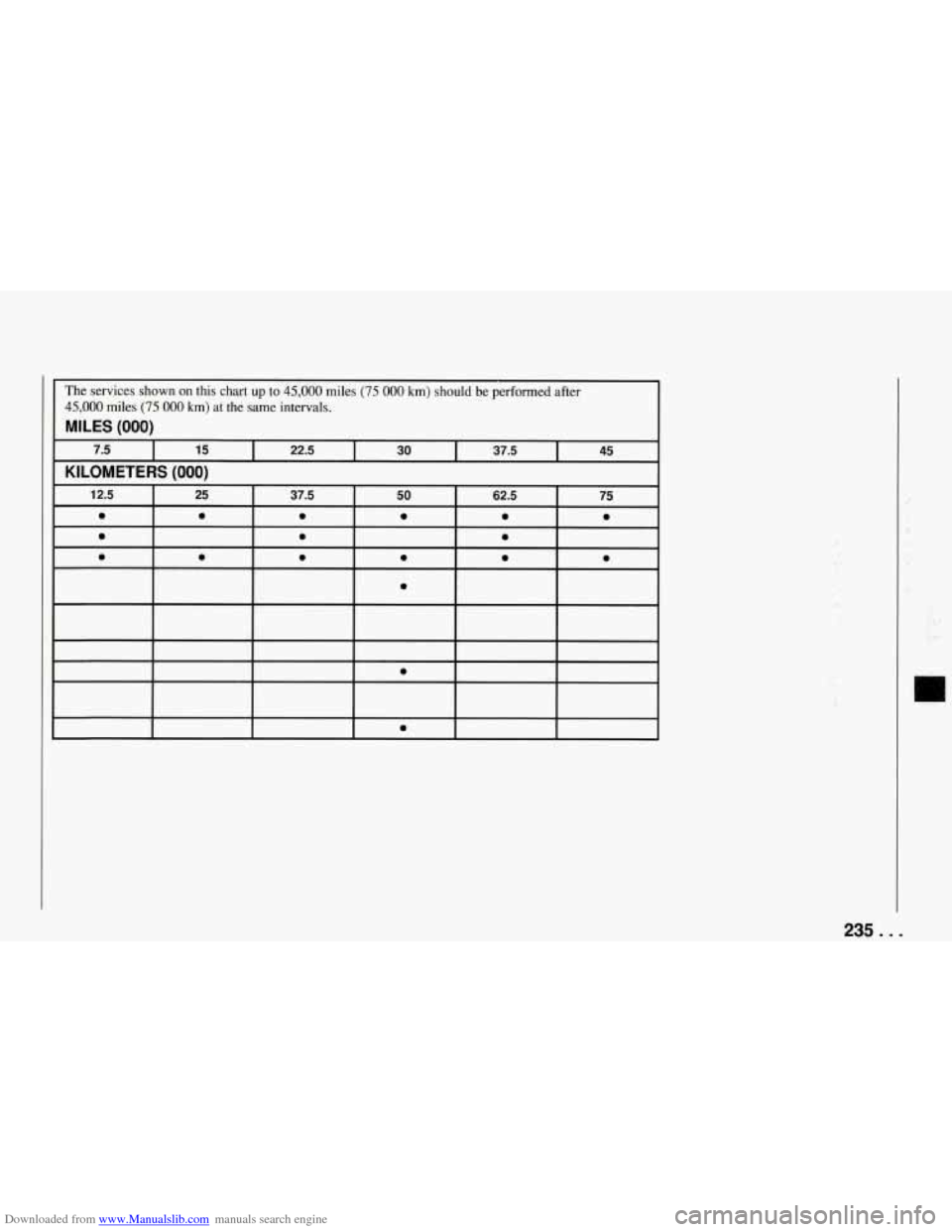
Downloaded from www.Manualslib.com manuals search engine The services shown on this chart up to 45,000 miles (75 000 km) should be performed after
45,000 miles (75
000 km) at the same intervals.
MILES (000)
7.5 I 15 I 22.5 I 30 I 37.5 I 45
KILOMETERS (000)
I I I 0 I I
235. . .
Page 237 of 274
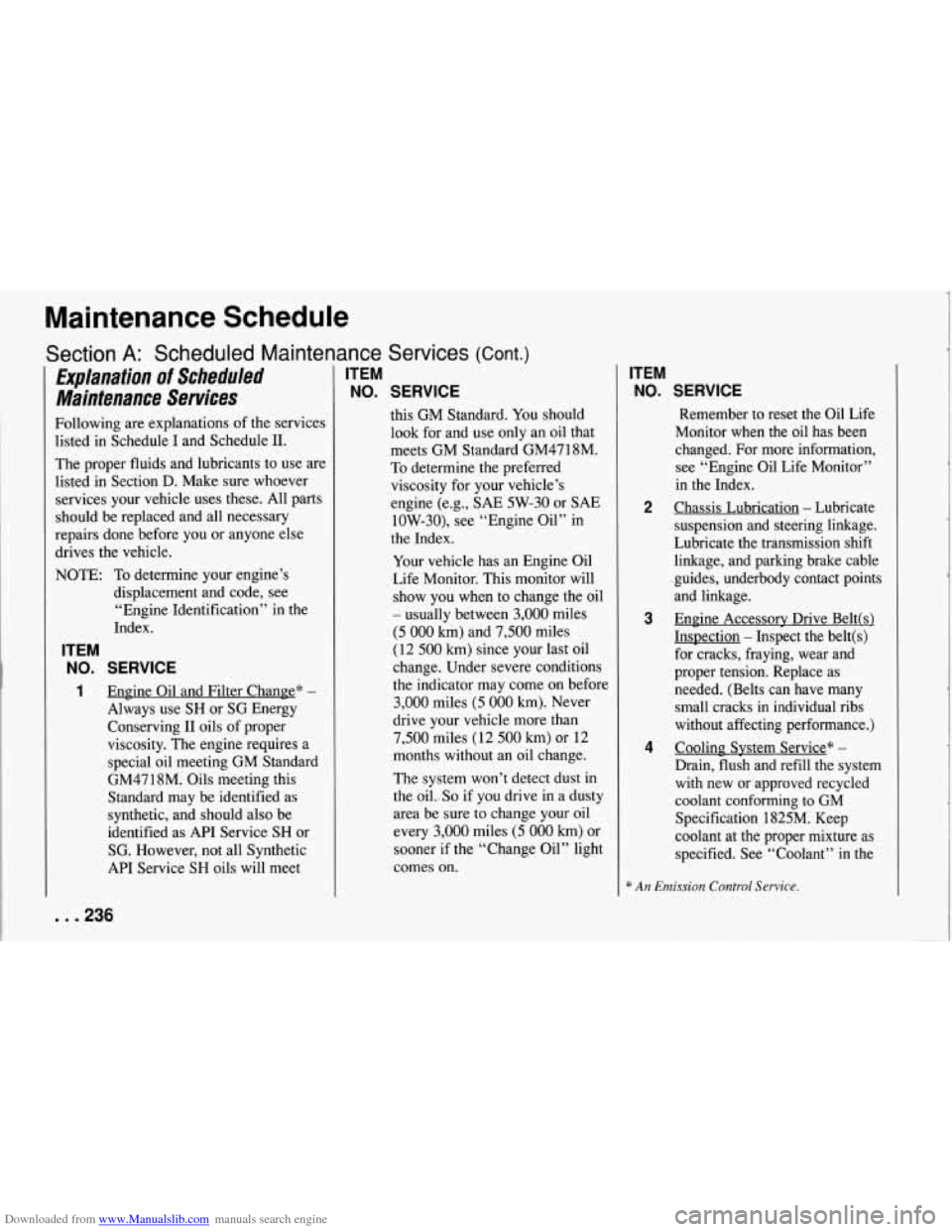
Downloaded from www.Manualslib.com manuals search engine Maintenance Schedule
C L Section A: Scheduled Maintenance Services (Cont.)
Explanation of Scheduled
Maintenance Services
Following are explanations of the services
listed in Schedule I and Schedule
11.
The proper fluids and lubricants to use are
listed in Section D. Make sure whoever
services your vehicle uses these. All parts
should be replaced and all necessary
repairs done before you or anyone else
drives the vehicle.
NOTE: To determine your engine’s
displacement and code, see
“Engine Identification” in the
Index.
ITEM
NO. SERVICE
1 Engine Oil and Filter Change* -
Always use SH or SG Energy
Conserving I1 oils of proper
viscosity. The engine requires a
special oil meeting GM Standard
GM4718M. Oils meeting this
Standard may be identified as
synthetic, and should also be
identified as API Service
SH or
SG. However, not all Synthetic
API Service
SH oils will meet
ITEM
NO. SERVICE
this GM Standard. You should
look for and use only an oil that
meets GM Standard GM4718M.
To determine the preferred
viscosity for your vehicle’s
engine (e.g.,
SAE 5W-30 or SAE
10W-30), see “Engine Oil” in
the Index.
Your vehicle has an Engine Oil
Life Monitor. This monitor will
show you when to change the oil
- usually between 3,000 miles
(5 000 km) and 7,500 miles
( 12 500 km) since your last oil
change. Under severe conditions
the indicator may come on before
3,000 miles
(5 000 km). Never
drive your vehicle more than
7,500 miles (12
500 km) or 12
months without an oil change.
The system won’t detect dust in
the oil..
So if you drive in a dusty
area be sure
to change your oil
every 3,000 miles
(5 000 km) or
sooner if the “Change Oil” light
comes on.
ITEM
NO.
2
3
4
SERVICE
Remember to reset the Oil Life
Monitor when the oil has been
changed. For more information, see “Engine Oil Life Monitor”
in the Index.
Chassis Lubrication
- Lubricate
suspension and steering linkage.
Lubricate the transmission shift
linkage, and parking brake cable guides, underbody contact points
and linkage.
Engine Accessory Drive Belt(s) Inspection
- Inspect the belt(s)
for cracks, fraying, wear and
proper tension. Replace as needed. (Belts can have many
small cracks in individual ribs
without affecting performance.)
Cooling System Service*
-
Drain, flush and refill the system with
new or approved recycled
coolant conforming to GM
Specification 1825M. Keep
coolant at the proper mixture as
specified. See “Coolant” in the
* An Emission Control Service.
. . .236
Page 238 of 274
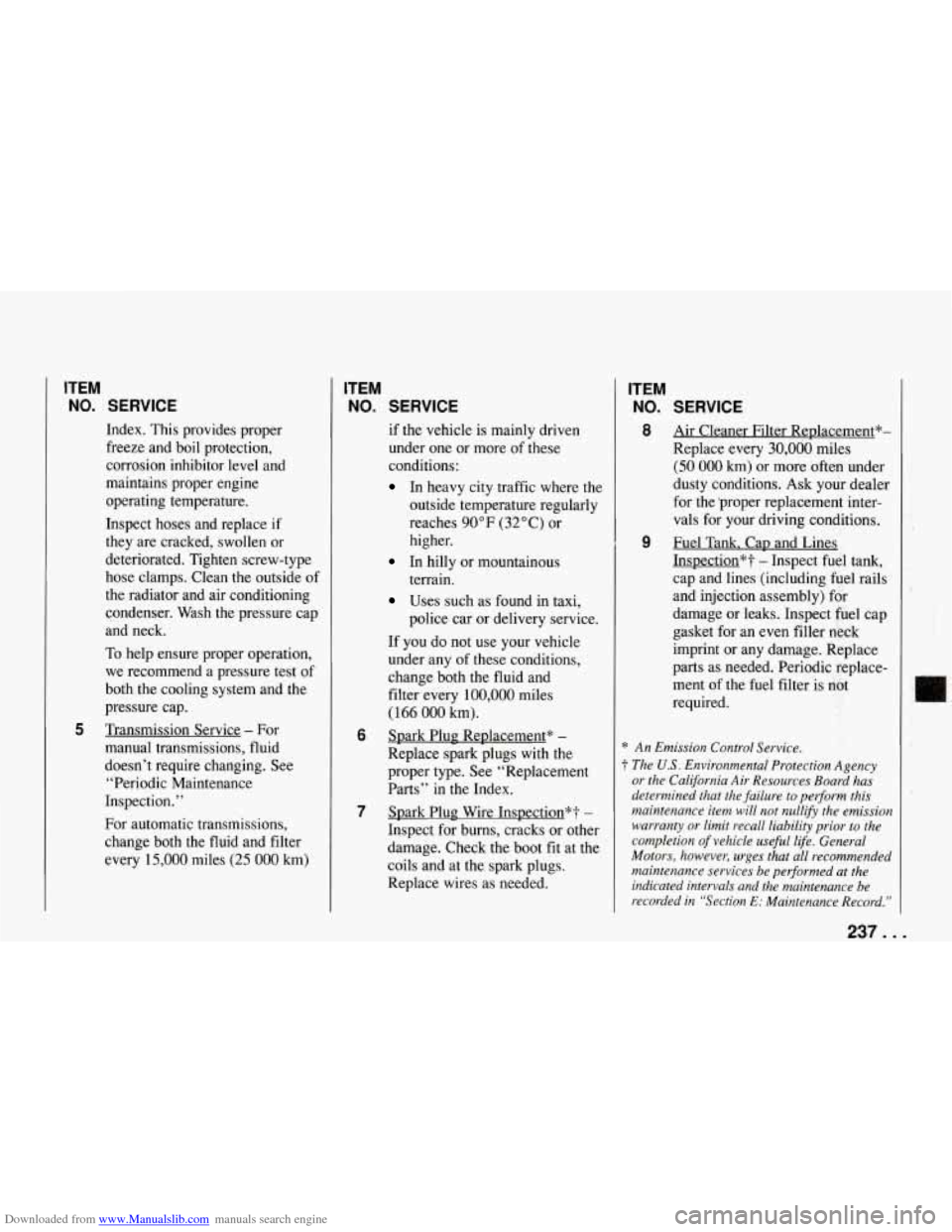
Downloaded from www.Manualslib.com manuals search engine ITEM
NO. SERVICE
Index. This provides proper
freeze and boil protection,
corrosion inhibitor level and
maintains proper engine
operating temperature.
Inspect hoses and replace if
they are cracked, swollen or
deteriorated. Tighten screw-type
hose clamps. Clean the outside of
the radiator and air conditioning
condenser. Wash the pressure cap
and neck.
To help ensure proper operation,
we recommend a pressure test of
both the cooling system and the
pressure cap.
5 Transmission Service - For
manual transmissions, fluid
doesn’t require changing. See
“Periodic Maintenance
Inspection.”
For automatic transmissions,
change both the fluid and filter
every
15,000 miles (25 000 km)
ITEM
NO. SERVICE
if the vehicle is mainly driven
under one or more of these
conditions:
In heavy city traffic where the
outside temperature regularly
reaches
90 OF (32 O C) or
higher.
In hilly or mountainous
terrain.
Uses such as found in taxi,
police car or delivery service.
If you do not use your vehicle
under any of these conditions,
change both
the fluid and
filter every
100,000 miles
(1 66 000 km).
Replace spark plugs with the
proper type. See “Replacement
Parts” in the Index.
6 Spark Plug Replacement* -
7 Spark Plug Wire Inspection*? -
Inspect for burns, cracks or other
damage. Check the boot fit at the
coils and at the spark plugs.
Replace wires as needed.
ITEM
NO. SERVICE
8 Air Cleaner Filter Replacement*-
Replace every
30,000 miles
(50 000 km) or more often under
dusty conditions. Ask your dealer
for the ’proper replacement inter-
vals for your driving conditions.
Inspection*?
- Inspect fuel tank,
cap and lines (including fuel rails
and injection assembly) for
damage or leaks. Inspect fuel cap
gasket for an even filler neck
imprint or any damage. Replace
parts as needed. Periodic replace-
ment of the fuel filter is not
required.
9 Fuel Tank. Cap and Lines
* An Emission Control Service.
t The U.S. Environmental Protection Agency
or the California Air Resources Board has
determined that the failure to perform this
maintenance item will not nullify the emission
warranty or limit recall liability prior to the
completion
of vehicle useful life. General
Motors, however, urges that all recommended
maintenance services be performed at the
indicated intervals and the maintenance be
recorded in “Section
E: Maintenance Record.”
I -I
237. . .
Page 239 of 274
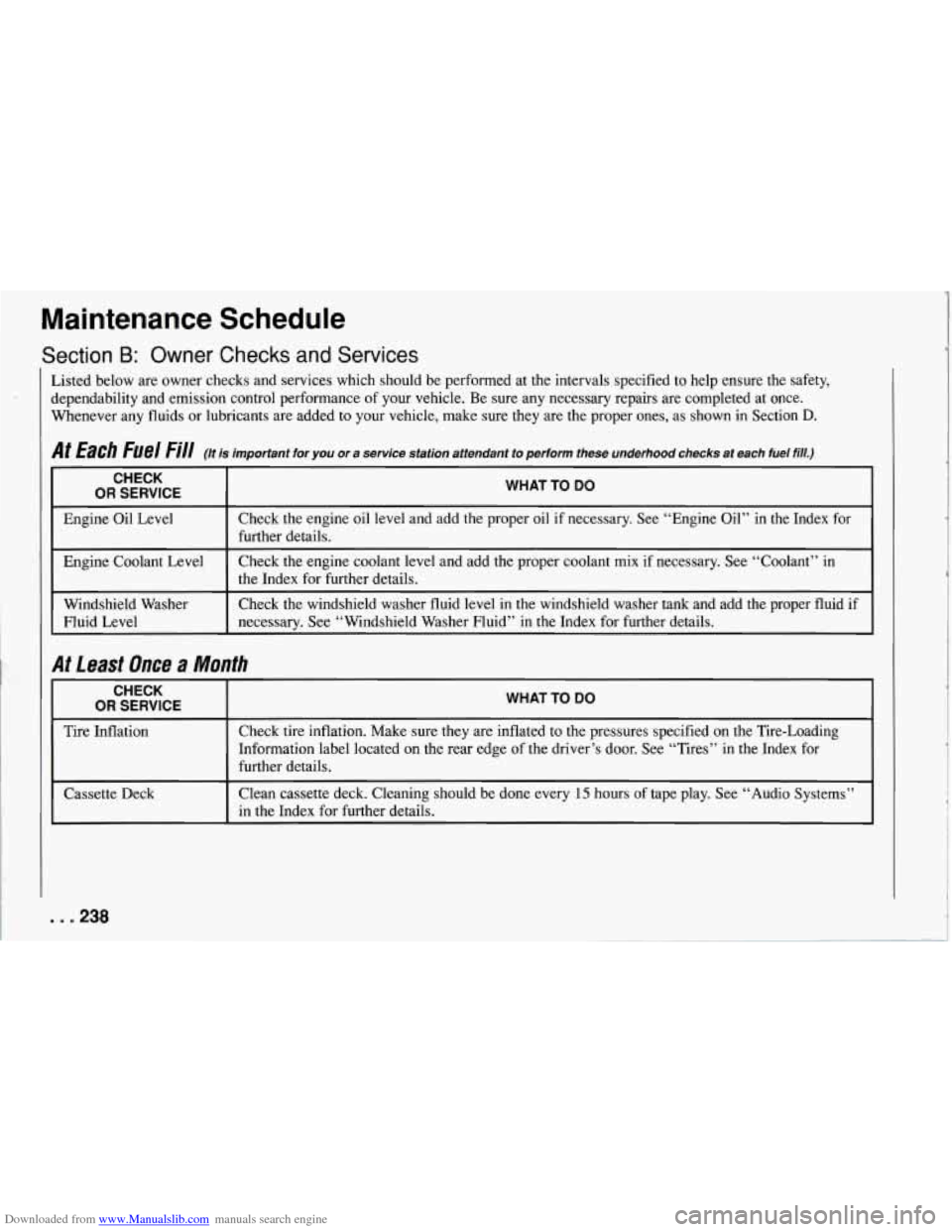
Downloaded from www.Manualslib.com manuals search engine Maintenance Schedule
Section B: Owner Checks and Services
isted below are owner checks and services which should be performed at the intervals specified to help ensure the safety,
ependability and emission control performance of your vehicle. Be sure any necessary repairs are completed at once.
Vhenever any fluids or lubricants are added
to your vehicle, make sure they are the proper ones, as shown in Section D.
If Each Fuel Fill (/t is important for you or a service station attendant to perform these underhood checks at each fuel fill.)
i CHECK
OR SERVICE I WHAT TO DO
Engine Oil Level
Check the windshield washer fluid level in the windshield washer
tank and add the proper fluid if
Windshield Washer Check
the engine coolant level and add the proper coolant mix if necessary. See “Coolant” in
Engine Coolant Level Check the
engine oil level and add the proper oil if necessary. See “Engine Oil” in the Index for
Fluid Level necessary.
See “Windshield Washer Fluid” in the Index for further details.
further details.
the
Index for further details.
It Least Once a Month
CHECK
OR SERVICE
Tire Inflation
Cassette Deck
WHAT TO DO
Check tire inflation. Make sure they are inflated to the pressures specified on the Tire-Loading
Information label located on the rear edge
of the driver’s door. See “Tires” in the Index for
further details.
Clean cassette deck. Cleaning should be done every
15 hours of tape play. See “Audio Systems”
in the Index for further details.
. .238
Page 240 of 274
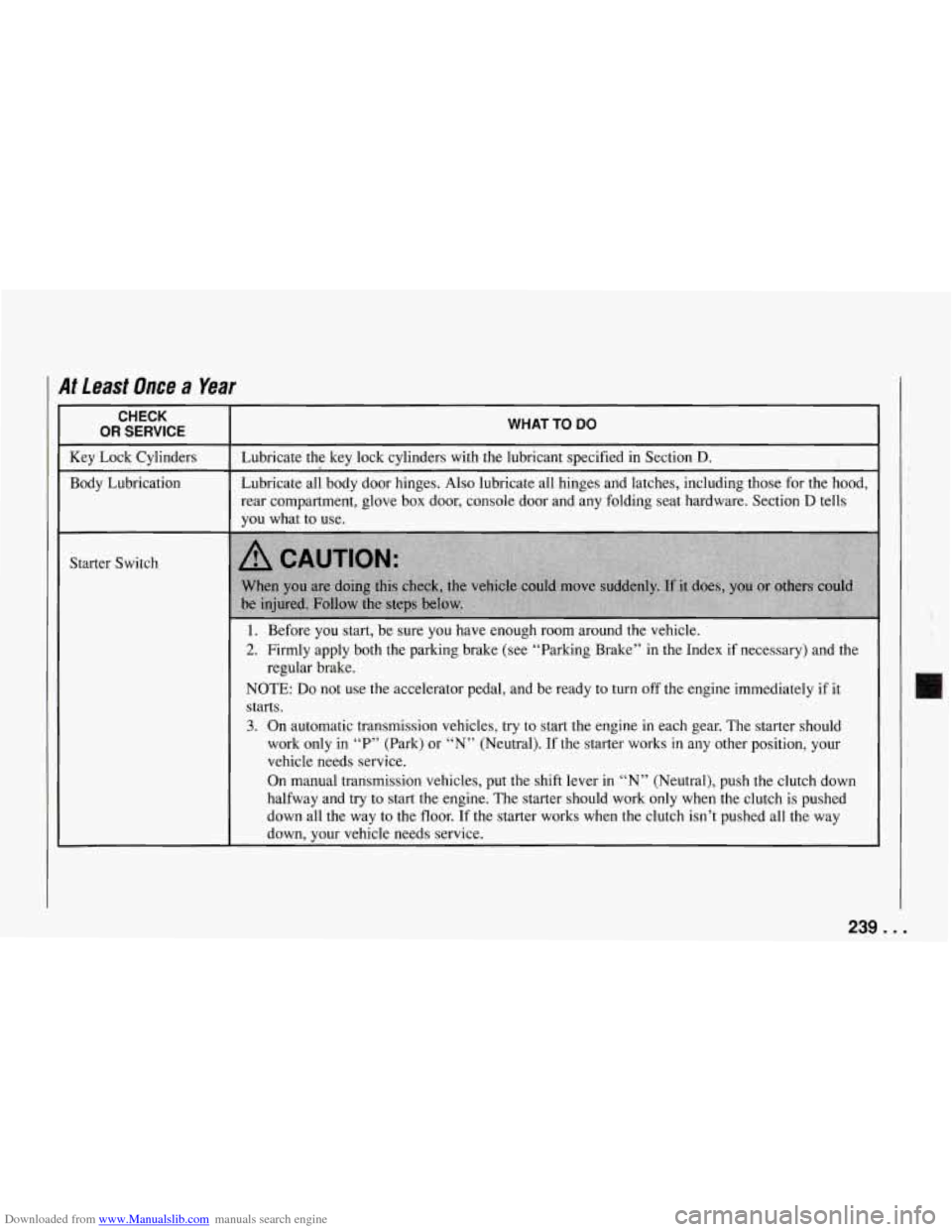
Downloaded from www.Manualslib.com manuals search engine I At Least Once a Year
WHAT TO DO
Lubricate the key lock cylinders with the lubricant specified in Section D.
Lubricate all body door hinges. Also lubricate all hinges and latches, including those for the hood,
rear compartment, glove box door, console door and any folding seat hardware. Section
D tells
you what to use.
1. Before you start, be sure you have enough room around the vehicle.
2. Firmly apply both the parking brake (see “Parking Brake” in the Index if necessary) and the
regular brake.
....
NOTE: Do not use the accelerator pedal, and be ready to turn off the engine immediately if it
starts.
3. On automatic transmission vehicles, try to start the engine in each gear. The starter should
work only in
“P” (Park) or “N” (Neutral). If the starter works in any other position, your
vehicle heeds service.
On manual transmission vehicles, put the shift lever in “N” (Neutral), push the clutch down
halfway and try to start the engine. The starter should work only when the clutch is pushed
down all the way to the floor. If the starter works when the clutch isn’t pushed all the way
down, your vehicle needs service.
r::. ,; II
U
239. . .